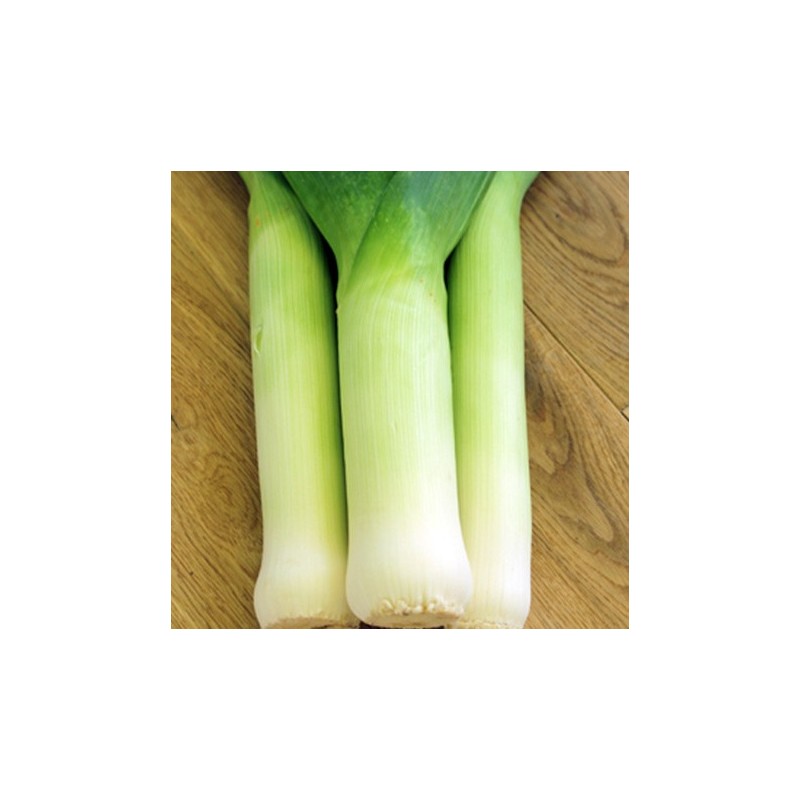



Leek Mammoth Blanch is the real show winner. Superior exhibition variety with extra long white blanch and thick, broad flag. Good cold tolerance and good taste too. RHS Award of Garden Merit winner. Can reach up to 2kg. Sow at a temperature of 15 Celsius. Be careful not to overwater the seedlings. Start inside early January for the end of summer shows. This seed is part of competition vegetable seeds collection.
How To Grow Giant Leeks From Seed
Leeks are a versatile vegetable and if you are someone who cannot get enough of them then perhaps you would like to try your hand at growing a giant leek. While, it should be said, growing giant vegetables is not really a pursuit for the novice gardener, those who have a few years of horticultural cultivation behind them may like to take on the challenge. One of these giant leeks could feed a family for a week!
Choosing Giant Leek Seeds:
First of all, it is important to note that not all leeks were created equal. You will never be able to grow a giant leek from a regular leek seed no matter how careful and assiduous you are. You will have to choose a specific giant leek seed, such as Mammoth blanch leek. Organic gardeners should note that while it is possible to grow giant leeks using organic fertilisers and organic growing methods, these giant leeks will likely be smaller than those grown using super-sizing chemicals. I would recommend considering the taste of your vegetables and how good they are for you, the health of the soil and the environment in general before deciding to go down the chemical route to super-charge your vegetables.
Sowing Giant Leek Seeds:
Sowing giant leek seeds begins with a great deal of preparation. Your growing area will have to be faultless if you want to grow some prize-winning giant leeks. A leek bed should be prepared well in advance of planting. It is a good idea to begin to prepare the area on a dry day in the late autumn or early winter. The site you choose should be sunny and well-drained. It is a good idea to add a quality of organic matter to improve the drainage of your site and to improve its fertility. Mounds or raised beds could be good places to sow your giant leeks as it will be easier to ensure good drainage.
Dig a trench for your giant leeks that is around 45cm deep, forking in the bottoms to further improve drainage and to loosen up any lumps or hard ground. It is a good idea to incorporate some phosphorus and potassium at this stage – whether you choose organic options or not is up to you. Knock back the soil into the trench you have dug and mix in a vast quality of an excellent quality compost or well-rotted manure to the top 10cm or so. You may also like to top dress with a good quality organic mulch to protect the soil surface over the winter and further add to the soil fertility – giant leeks are very hungry plants.
Sow your giant leek seeds indoors from the end of January to the end of February. Fill a seed tray with good quality compost and level gently but avoid compacting the soil. Broadcast the giant leek seeds over the tray and lightly cover with well-sifted compost. Place the seed tray in a larger tray filled with water and allow the compost to become saturated from beneath. Tip out excess water from the tray and set the seeds in a well lit area – a sunny windowsill is ideal. Cover the tray to prevent evaporation until the first seedlings emerge. Make sure the soil does not dry out or become waterlogged. Giant leeks should germinate after around two weeks.
In March, check over the bed you prepared before the winter and gently rake over the surface, adding yet more fertilisers. Calcified seaweed could be one good option. Organic options can be used.
Growing Giant Leeks:
When the leeks look like little shepherd's crooks, move them gently (using a pencil or similar) into individual 9cm pots. Re-pot leeks into larger containers when they have developed their third leaves. Harden off before planting out your giant leeks into their prepared bed in May. Protecting your leeks with a cloche or polytunnel for a month or so after they have been transplanted to their final growing positions may help give them a good start.
Leeks must be well watered during the growing season or their stalks can become woody and growth will be stunted. To reduce water loss from the soil, it is a good idea to mulch around your giant leeks with a mulch of seaweed, compost and weed-free green material in a thick layer. This mulch will also help giant leeks with their nutritional needs.
ground to prevent any damage.